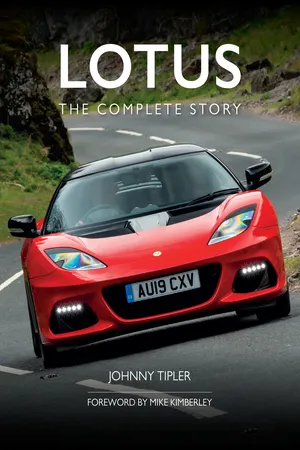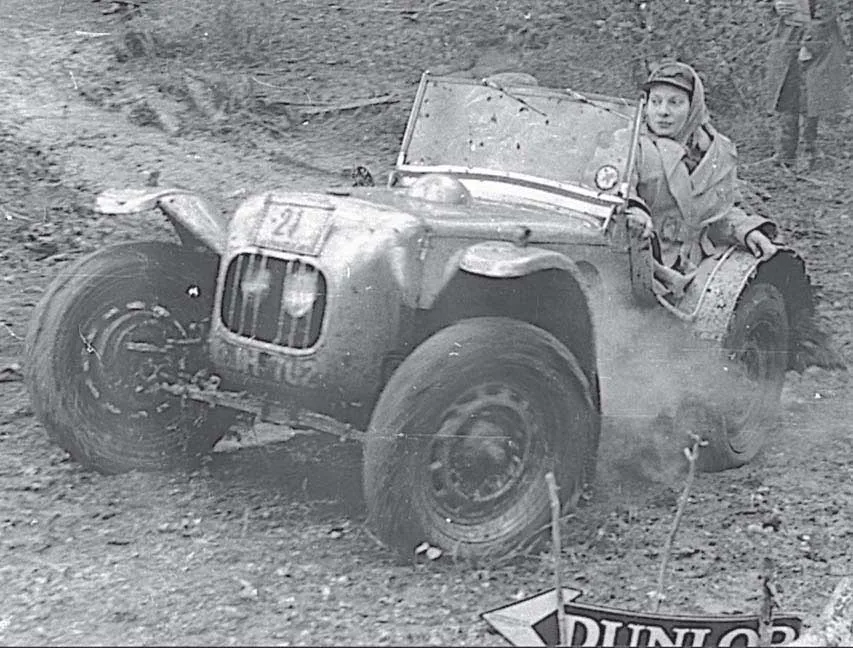![]()
CHAPTER ONE
THE HORNSEY YEARS, 1952–60
Company founder Colin Chapman enrolled at University College, London, in 1945, to read structural engineering. While there, Chapman and his friend Colin Dare traded second-hand cars, helped by the fact that the Warren Street dealers’ mecca was very close by; but when the basic petrol ration was suddenly withdrawn in October 1947 – and fuel rationing continued until 1954 – Chapman was left with a stock of cars that he had to sell off at a loss. The last one was a fabric-bodied Austin 7, and he dismantled it and clad the chassis in alloy-bonded plywood for greater rigidity. Chapman was a member of the university air squadron and to a degree it followed the principles of aircraft construction.
A decade later, Lotus took a stand at the Do-It-Yourself Exhibition, demonstrating just how long the make-do ethos held sway. Those were the days of new artificial materials like Formica and Fablon, of plywood and chipboard, and it was respectable enough for up-and-coming celebrities, including Graham Hill, to visit the Lotus stand. Chapman’s first effort at a trials car in 1948, retrospectively named the Lotus Mk 1, was essentially an Austin 7.
Ron Gammons in his Eleven Le Mans during the Masters Historic Sports Cars round at Portimao, part of the Algarve Classic Festival.
THE FIRST LOTUSES
Chapman spent time mulling over technical treatises at the Institute of Mechanical Engineers’ library to discover what stresses cars were subjected to, and what had to be done to counteract them, and his early cars began to embody some of the principles he absorbed. Not many car designers took these things as seriously as Chapman, and the spaceframe chassis and aerodynamic bodied models of the 1950s should be viewed in this light. He extended the rear of the Mk 1 body to accommodate passengers – or trialling ballast. The Austin 7 special was assembled in a lock-up garage behind his girlfriend Hazel Williams’ parents’ home in Alexandra Park Road, north London. She supported Colin in his obsession with cars and speed, providing him with the wherewithal and premises for tinkering with engines.
Inspired by ‘mud-plugging’ trials competition, Colin Chapman created his own contender from a twentyyear old Austin Seven in 1948, replacing the fabric panels with aluminium to produce the Mk 1 Lotus.
Colin Chapman, right, and a bunch of girlfriends cluster round the Mk 1 at a trials event in 1948.
The car was registered OX 9292 as a Lotus Mk 1, early in 1948, and Chapman, partnered by Hazel, campaigned it successfully in the mud and ruts of trials competitions as far afield as Cheshire from 1948. Perhaps Chapman’s most notable discovery was that inverting the rear leaf springs cured the Austin 7’s propensity to oversteer. He also created an independent front end by splitting the front axle beam and pivoting it in the centre, thus ensuring the wheels were vertical during cornering.
Mike Lawson and passenger trialling at Horsham in the Mk 2 in 1951. The Mk 2 also featured in Brothers in Law, a 1957 comedy starring Richard Attenborough, Ian Carmichael, Terry-Thomas, Nicholas Parsons and Jill Adams.
The Lotus Mk 2 was based on a modified Austin Seven chassis with 1172cc Ford engine and Austin gearbox. Chapman competed in the Silverstone ‘Eight Clubs’ race in June 1949 and beat a well-known Bugatti: after that, circuit racing became the focus.
Pictured at Goodwood Festival of Speed, this Mk 2 Lotus was sold to Mark Lawson in October 1950, who won the Wrotham Cup trials. It was raced and trialled by a succession of owners during the 1950s, including Hampshire-based Arthur Hay, passing to Nigel Halliday in 1989.
While doing his national service in the RAF, Chapman learned to fly in a Harvard two-seat trainer, and this was to stand him in good stead in later life as he commuted from home base to Grand Prix circuit. In his spare time, he built the Mk 2 Lotus, which was another Austin 7 chassis clad in a rudimentary cigar-tube body – as many specials were at the time, including Trevor Wilkinson’s first TVRs. It was a slightly more sporty-looking machine than the Mk 1 and, six years on, featured as the honeymoon car in a Boulting Brothers’ comedy called Brothers in Law.
Beneath the skin, the Mk 2’s main chassis members were boxed in, and tubular braces replaced the existing cross-members. It used a 993cc Ford 8 engine (8hp), replaced later with an 1172cc Ford 10 (10hp) unit, and its Austin 7 rear axle was retained. Chapman arrived at a 4.55:1 final drive by pairing up an unmatched 42-tooth crown wheel with a nine-tooth pinion, filling the differential with metal polish and driving it for 50 miles (80km) to bed it in. The bearings were shot, but the crown wheel and pinion now meshed perfectly.
Wheels were also Ford pressed steel, because they allowed the use of fatter tyres. Whereas the venerable Ford 8 engine was adapted to take a four-speed Austin gearbox, the second engine required no such refinement. It was virtually brand new, obtained from a burned-out Ford 10, and the manner of its acquisition is a measure of Chapman’s resourcefulness in times of penury, a quality that would stand him in good stead throughout his life. It seems he bought the wreck from the insurance company for £30, having arranged for a shady dealer to buy the shell for £35, plus allimportant log-book, but minus engine and gearbox. A middle man acted as breaker, removed the drivetrain and passed on the remains to the dealer. Chapman thus got himself a free engine for the Mk 2.
Virtually every weekend, Chapman and Hazel or another friend were involved in a motor club trial or rally, or entered some 750 Formula club event in this car, and successes were many. But after his first proper race, the Eight Clubs meeting at Silverstone on 3 June 1950, where he beat Dudley Gahagan’s Type 37 Bugatti to the chequered flag, Chapman became more interested in building a car that could beat all comers on the road, rather than the unpredictable terrain of a trials course. So, the Mk 2 was sold through a Motor Sport advert to Mike Lawson, who continued to be successful with it.
COLIN CHAPMAN’S EARLY YEARS
Born 19 May 1928, Colin Chapman grew up in Muswell Hill, north London. Subsequently, his parents, Stan and Mary, ran the Railway Hotel at 5 Tottenham Lane, Hornsey, and it was from outbuildings adjacent to the pub that Lotus Cars first saw the light of day. Fred Bushell, who would shortly become Colin’s right-hand man as company secretary and head of finance – enabling and facilitating all manner of acquisitions and benefits – paints a vivid picture in his diaries of the scene he glimpsed from the top deck of the No. 41 bus, on his way home from his accountancy job in the City, in 1953:
After a year as a construction engineer with a steel-erection company in London, Colin Chapman joined British Aluminium on 17 April 1950 in a similar role. Road-going transport at the time was a rare Austin 7 aluminium saloon, later passed on to the Costins, first Mike, then Frank, having clocked up over 100,000 miles (160,000km).
The 750 Motor Club was founded in 1938 as a platform for owners of the 750cc Austin 7 to indulge in some sporting motoring. The basic car was a plodder, but the Ulster, Speedy and Nippy derivatives lived up to their names. In 1950, Holly Birkett established the unsupercharged 750 Formula for Austin 7s to go club racing, and Chapman was sufficiently impressed to base his next creation, and its successors, on the 750 Motor Club’s formula.
MK 6: ON THE RIGHT TRACK
In 1951, Chapman made a move away from trialling to the circuits with his next creation: the equally austere and spindly Mk 3. The basis for this car was a 1930 Austin 7, bought for £15 and gutted, its chassis side-members boxed in and the cross-members replaced with 14-gauge tubular beams. It was the first Lotus to bear the ACBC badge logo – a clever signature comprised of Antony Colin Bruce Chapman’s entwined initials.
Surrounded by admirers, the Mk 3 was the first car to bear the Lotus badge. Raced by Colin Chapman in the 750 Motor Club’s 750cc series in 1951, it was powered by a 750cc Austin engine. The first customer car, constructed for Adam Currie and called the Mk 3B, sold in 2015 for $247,500.
He became friendly with the Allen brothers, Nigel and Michael, 750 Motor Club members who lived with their parents at 104 Vallance Road in nearby Alexandra Park, and had decent garage-workshop facilities. According to Peter Ross’s Lotus: The Early Years, the Allens were in the process of converting an Austin 7 into a sports car when Colin Chapman stopped by and persuaded them they should be into racing cars. They were fired by Chapman’s enthusiasm into buying a pair of cars similar to the Mk 3 Lotus, and were closely involved in the gestation of the seminally important Mk 6.
When the Allen boys’ neighbours complained about the ceaseless vehicular activities, the Lotus operation was obliged to relocate to the aforementioned stables behind the Chapman family’s Railway Hotel. This also prompted the listing of Lotus as a registered company, although not as a limited company at the time. The first task was to l...







